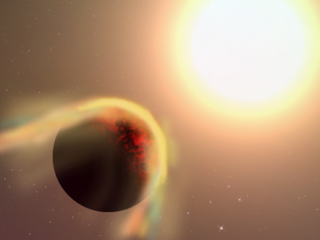
An exoplanet or extrasolar planet is a planet outside the Solar System. The first possible evidence of an exoplanet was noted in 1917 but was not recognized as such. The first confirmation of the detection occurred in 1992. A different planet, initially detected in 1988, was confirmed in 2003. As of 1 December 2023, there are 5,550 confirmed exoplanets in 4,089 planetary systems, with 887 systems having more than one planet. The James Webb Space Telescope (JWST) is expected to discover more exoplanets, and also much more about exoplanets, including composition, environmental conditions and potential for life.

CoRoT was a space telescope mission which operated from 2006 to 2013. The mission's two objectives were to search for extrasolar planets with short orbital periods, particularly those of large terrestrial size, and to perform asteroseismology by measuring solar-like oscillations in stars. The mission was led by the French Space Agency (CNES) in conjunction with the European Space Agency (ESA) and other international partners.

Pegasus is a constellation in the northern sky, named after the winged horse Pegasus in Greek mythology. It was one of the 48 constellations listed by the 2nd-century astronomer Ptolemy, and is one of the 88 constellations recognised today.
51 Pegasi, formally named Helvetios, is a Sun-like star located 50.6 light-years from Earth in the constellation of Pegasus. It was the first main-sequence star found to have an exoplanet orbiting it.

55 Cancri b, occasionally designated 55 Cancri Ab, also named Galileo, is an exoplanet orbiting the Sun-like star 55 Cancri A every 14.65 days. It is the second planet in order of distance from its star, and is an example of a hot Jupiter, or possibly rather "warm Jupiter".

These are lists of exoplanets. As of 19 December 2023, there are 5,566 confirmed exoplanets in 4,140 planetary systems, with 942 systems having more than one planet. Most of these were discovered by the Kepler space telescope. There are an additional 1,984 potential exoplanets from Kepler's first mission yet to be confirmed, as well as 977 from its "Second Light" mission and 4,589 from the Transiting Exoplanet Survey Satellite (TESS) mission.

IK Pegasi is a binary star system in the constellation Pegasus. It is just luminous enough to be seen with the unaided eye, at a distance of about 154 light years from the Solar System.

V391 Pegasi, also catalogued as HS 2201+2610, is a blue-white subdwarf star approximately 4,000 light-years away in the constellation of Pegasus. The star is classified as an "extreme horizontal branch star". It is small, with only half the mass and a bit less than one quarter the diameter of the Sun. It has luminosity 34 times that of the Sun. It could be quite old, perhaps in excess of 10 Gyr. It is a pulsating variable star of the V361 Hydrae type. It is believed that the star's mass when it was still on the main sequence was between 0.8 and 0.9 times that of the Sun.

A B-type subdwarf (sdB) is a kind of subdwarf star with spectral type B. They differ from the typical subdwarf by being much hotter and brighter. They are situated at the "extreme horizontal branch" of the Hertzsprung–Russell diagram. Masses of these stars are around 0.5 solar masses, and they contain only about 1% hydrogen, with the rest being helium. Their radius is from 0.15 to 0.25 solar radii, and their temperature is from 20,000 to 40,000 K.
HD 40307 b is an extrasolar planet orbiting the star HD 40307, located 42 light-years away in the direction of the southern constellation Pictor. The planet was discovered by the radial velocity method, using the European Southern Observatory's HARPS apparatus, in June 2008. It is the second smallest of the planets orbiting the star, after HD 40307 e. The planet is of interest as this star has relatively low metallicity, supporting a hypothesis that different metallicities in protostars determine what kind of planets they will form.
HD 40307 d is an extrasolar planet orbiting the star HD 40307, located 42 light-years from Earth in the direction of the southern constellation Pictor. The planet was discovered by the radial velocity method, using the HARPS apparatus in June 2008. It is the most massive of the six proposed planets in the system. The planet is of interest as this star has relatively low metallicity, supporting a hypothesis that different metallicities in protostars determine what kind of planets they will form.

HW Virginis, abbreviated HW Vir, is an eclipsing binary system, approximately 563 light-years away based on the parallax measured by the Gaia spacecraft, in the constellation of Virgo. The system comprises an eclipsing B-type subdwarf star and red dwarf star. The two stars orbit each other every 0.116795 days.

Kepler-70b is one of two postulated exoplanets orbiting the subdwarf B star (sdB) Kepler-70. The other planet is Kepler-70c, and both planets orbit very close to their host star.
Kepler-70, also known as KIC 5807616 and KOI-55, is a star about 3,600 light-years away in the constellation Cygnus, with an apparent visual magnitude of 14.87. This is too faint to be seen with the naked eye; viewing it requires a telescope with an aperture of 40 cm (20 in) or more. A subdwarf B star, Kepler-70 passed through the red giant stage some 18.4 million years ago. In its present-day state, it is fusing helium in its core. Once it runs out of helium it will contract to form a white dwarf. It has a relatively small radius of about 0.2 times the Sun's radius; white dwarfs are generally much smaller. The star may be host to a planetary system with two planets, although later research indicates that this is not in fact the case.
Kepler-70c is one of two postulated exoplanets orbiting the sdB star Kepler-70. Their discovery was announced in 2011. However, later research suggests that the two exoplanets probably do not exist, and that "pulsation modes visible beyond the cut-off frequency of the star" were a more likely explanation for the signals believed to indicate exoplanets. This is not proven with certainty one way or the other.
Planet-hosting stars are stars which host planets, therefore forming planetary systems.
Kepler-429 is a variable subdwarf B star in the constellation Lyra, about 5,900 light years away.

57 Pegasi is a variable binary star system in the northern constellation of Pegasus (constellation). It has the variable star designation GZ Pegasi, while 57 Pegasi is the Flamsteed designation. The system is faintly visible to the naked eye as a point of light with an apparent visual magnitude that fluctuates around 5.105. It is located at a distance of approximately 780 light years from the Sun based on parallax, and is drifting further away with a radial velocity of +14 km/s.











